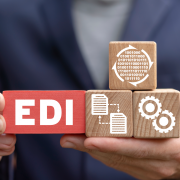Cloud ERP and EDI: What You Need To Know
What is EDI?
Electronic Data Interchange (EDI) is a term used to refer to the use of computers to electronically exchange business documents between trading partners (generally a customer and their vendor) using a standardized file format.
Leveraging EDI allows both parties to save money on manual work. For example, imagine a customer that places 50 orders a day with their vendor. Without EDI, their process might look something like this for every order that is placed:
- Customer prepares a purchase order to the vendor
- Customer e-mails the purchase order to the vendor
- Vendor replies to the email to confirm receipt of the purchase order
- Vendor enters the purchase order into their system
- Vendor processes the order and emails a shipment notification to the customer, copying and pasting a tracking number
- Vendor’s accounting team sends an invoice to the customer
This type of manual work requires a significant amount of manual effort every step of the way. And along with being time-consuming, each step introduces the opportunity for human error, and corresponding additional work to fix the mistake.
Now let’s take a look at what the same process would look like with EDI:
- Customer prepares a purchase order to the vendor and clicks a “send” button
- The purchase order automatically appears in the vendor’s ERP system, and the order is automatically confirmed with an electronic acknowledgement
- Vendor processes the order
- An advance shipment notification (ASN) and invoice automatically appear in the customer’s ERP system
Through the use of EDI, we’ve eliminated nearly all the manual work involved in the process, speeding up the procure-to-pay cycle for the customer AND the order-to-cash cycle for the vendor.
EDI File Formats
The most popular way to exchange EDI messages is ANSI X12, a standardized file format developed in 1979. The X12 standard provides file formats for documents exchanged in a wide variety of industries – not just manufacturing and distribution, but also banking, insurance, government, and transportation.
Along with X12, some businesses have developed their own EDI formats – sometimes using XML or CSV files – which they prefer to use instead of X12.
Regardless of the file format your trading partner uses, one thing is certain: it will almost definitely be unique! While X12 provides a baseline specification, many companies have their own variations on the X12 standard. And even if your trading partner uses by-the-book X12, mapping is often necessary to translate the vendor’s message into a format your system will understand.
Means of Connectivity
When you’re ready to connect with a vendor via EDI, several options are available for that connectivity:
- Direct (point to point) EDI refers to a direct connection between your ERP system and the counterpart’s ERP system. A direct connection provides the most flexibility, but requires the most upfront work (configuration and testing) to set up. This also requires that your ERP system is capable of direct EDI connectivity.
- VAN-based EDI refers to the use of a third-party VAN (Value-Added Network) to transmit documents. In this scenario, the document formats are still specific to your trading partner (as with direct EDI), but the VAN is handling the underlying infrastructure to receive and transmit documents.
- Partner EDI refers to the use of a third-party mapping partner in between your ERP system and your trading partners. The mapping partner receives documents from your ERP system in a standardized format, then translates those documents to your trading partners’ formats and transmits them to the partner, either using direct or VAN-based connections.
Choosing the right option for you will depend on the capabilities of your ERP system, the number of trading partners, and number of messages exchanged. In many cases, using a mapping partner will make it easy to quickly implement new EDI interfaces, and the upfront costs tend to be lower. Direct or VAN-based connectivity can be more effective if you have a small number of EDI interfaces that have high transaction volume.
Bizowie Cloud ERP’s EDI module supports all of these options, and customers can choose which is the best fit for their business.
EDI Portals vs. True EDI
In recent years, there has been an increased need to “bridge the gap” between large companies that require EDI for their trading partners and their smaller counterparts who may not have EDI capabilities.
To solve this problem, many EDI providers are now offering web-based “EDI portals”, which allow trading partners to log in and manually enter data, which the portal then transmits over EDI. These portals allow you to remain “EDI compliant” with your counterpart, without the time and expense of a fully automated EDI implementation.
While EDI portals provide an important stopgap solution for small businesses, it is critical to note that they are not fully integrated EDI. They still require a person to log in and enter data manually. (For example, you could use your customer’s EDI portal to view their orders and enter your invoices, but you would still need to enter the sales order manually in your system and the invoice manually in the EDI portal.)
When getting quotes for EDI services, be sure to let the vendor know that you are looking for full EDI integrated with your system, NOT a web portal.

